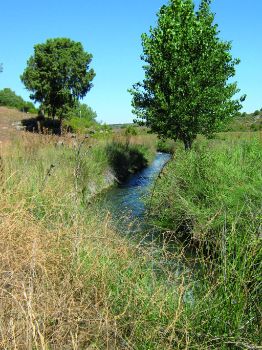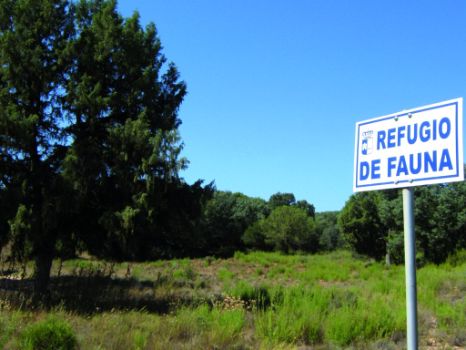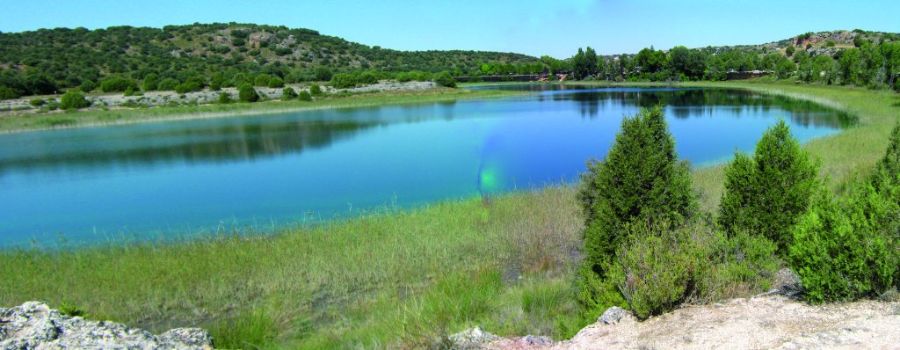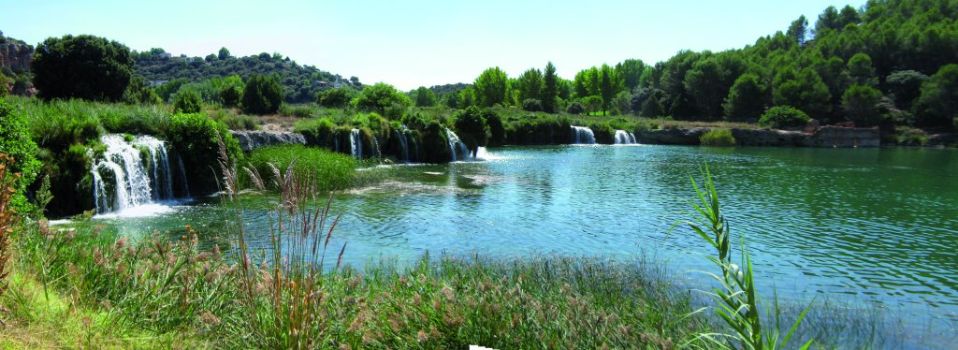Net of Natural
Trails

Stage 1: Laguna Blanca - Ruidera
Description
Walking amidst greenish-blue lagoons
This Stage runs between lakes and waterfalls within the Lagunas de Ruidera Nature Park, surrounded by junipers and holm oaks, rosemary and thyme, and several recreational areas where one can enjoy the landscape and water.
Las Lagunas de Ruidera, declared a Nature Park and Site of Community Importance (SCI), is a collection of 15 lakes oriented in the southeast to northwest direction located along the upper reaches of the Alto Guadiana, a limestone valley in the Campo de Montiel moorland. The Trail begins at the Km 15 milestone of the CR-640 road to Montiel, at the detour to Laguna Blanca. In the initial stretch of the Trail, only authorised motorised vehicles may use this road; nonetheless, caution should be exercised.

The Stage continues straight ahead at the crossroads, as the left branch leads to Blanca Lagoon. At the next fork, the route turns right, heading towards a high ground from where one can contemplate the Mediterranean scrub landscape before it continues down a steep path.
The route proceeds along a very sandy stretch through the flood plains of the River Pinilla, then turns left towards the river. Further on, it continues through a Wildlife Refuge Area towards Concejo Lagoon. The collection of lagoons that form the Nature Park provide resting areas, shelter and forage for many species.
The number of waterfowls and the diversity of species vary throughout the year. The largest concentration takes place in winter, when the birds look for shelter after their migrations from areas further north. The most notable species include the Common Pochard (Aythya ferina), Tufted Duck (Aythya fuligula), Red-crested Pochard (Netta rufina), Common Coot (Fulica atra), Mallard (Anas platyrhynchos) and the Great Crested Grebe (Podiceps cristatus).

One can also observe Grey Herons (Ardea cinerea) foraging along the banks of the lagoons, as well as raptors such as the Western Marsh Harrier (Circus aeruginosus) which, as the name suggests, depends on wetlands to survive.
The area around the lagoons is also rife with Red-legged Partridge (Alectoris rufa), Azure-winged Magpie (Cyanopica cianus), Wood Pigeon (Columba palumbus), European Turtle Dove (Streptopelia turtur), European Bee-eater(Merops apiaster), and Bonelli's Eagle (Hieraaetus fasciatus).
Common mammal species include rabbit (Oryctolagus cuniculus), fox(Vulpes vulpes), common genet (Genetta genetta) and several bat species that use cavities and caves for resting and wintering.
The Concejo Lagoon is populated with tall vegetation, primarily reed (Phragmites australis), bulrush(Typha dominguensis) and soft-stem bulrush(Scirpus tabernaemontani), They may even form a dense blanket that conceals the water below, except in those areas where the Trail runs over high ground.

The Stage reaches a paved area near Tomilla Lagoon, a nature reserve. From here, the route shares the road with motorised traffic for about one kilometre along the AB-651. There are signs indicating the distance and direction to the different lagoons and the town of Ruidera. At the opposite end of Tomilla Lagoon, the route turns right at the intersection towards "Montesol" Restaurant, next to a small diversion dam that separates this lagoon from the next. Opposite the restaurant is a dirt road leading to Tinaja Lagoon, which passes through a residential area of villas. One can rest and admire the lake landscape that contrasts with the surrounding, relatively barren area. Here stands the formation popularly known as the "bullring", owing to its similarity in appearance.
San Pedro is the next lagoon on the Trail, with large holm oak and juniper forests. The abundant scrubland consists primarily of broom, which thrive in the deep soil of Meso-Mediterranean areas, and kermes oaks, with a scattering of prickly junipers (Juniperus oxycedrus) and black hawthorn(Rhamnus lycioides). The more degraded areas are populated with rosemary and lavender(Lavandula angustifolia). Some areas are dehesas with holm oaks, which belies its agricultural value. For about 500 m, the Stage runs between this lagoon and Tinaja Lagoon until it reaches an intersection, where it turns right onto a paved road; hence, caution should be exercised.
The Trail to Ruidera is interrupted here, as the route can only continue along the AB-650 (or CR-650). This road can at times be very dangerous due to heavy traffic and bends without shoulders.

The next lagoon on the route is Redondilla, named for its roughly circular morphology. The water cascades into the next lagoon named Lengua, which has a viewpoint from where one can enjoy the scenery. Different fish species abound in these lagoons, including Iberian nase (Chondrostroma polylepis) carp(Cyprinus carpio), and other alien or exotic species, such as pike(Esox lucius) or largemouth bass (Micropterus salmoides).
On the opposite side of Lengua Lagoon, the water cascades into Salvadora Lagoon. There is a recreational area with a swimming beach, snack bar and canoe rental facilities.
The lagoons appear, one after another: first, Santos Morcillo, then Batanás, Colgada and Rey. All these lagoons are denominated "upper" lagoons characterised by tuff barriers that create waterfalls. Additionally, the lagoons are surrounded by embankments and cliffs, and water appears of a greenish-blue hue due to the depth. Downstream from Rey Lagoon are the "lower" lagoons, which the traveller may visit in the next Stage of the Trail.
This Stage ends at Ruidera, at the intersection with the N-430, next to a kiosk. On the opposite side is an information office with brochures about the Park. The Ruidera Nature Park Visitor's Centre, located in the town centre, provides information on tours. It also has an audio-visual program with detailed information of the Park. Another Information Centre remains open in summer next to Santos Morcillo Lagoon. There is a Public Safety and Protection Plan in place to assist the visitors, which also includes medical care.
Sites of interest
Profile
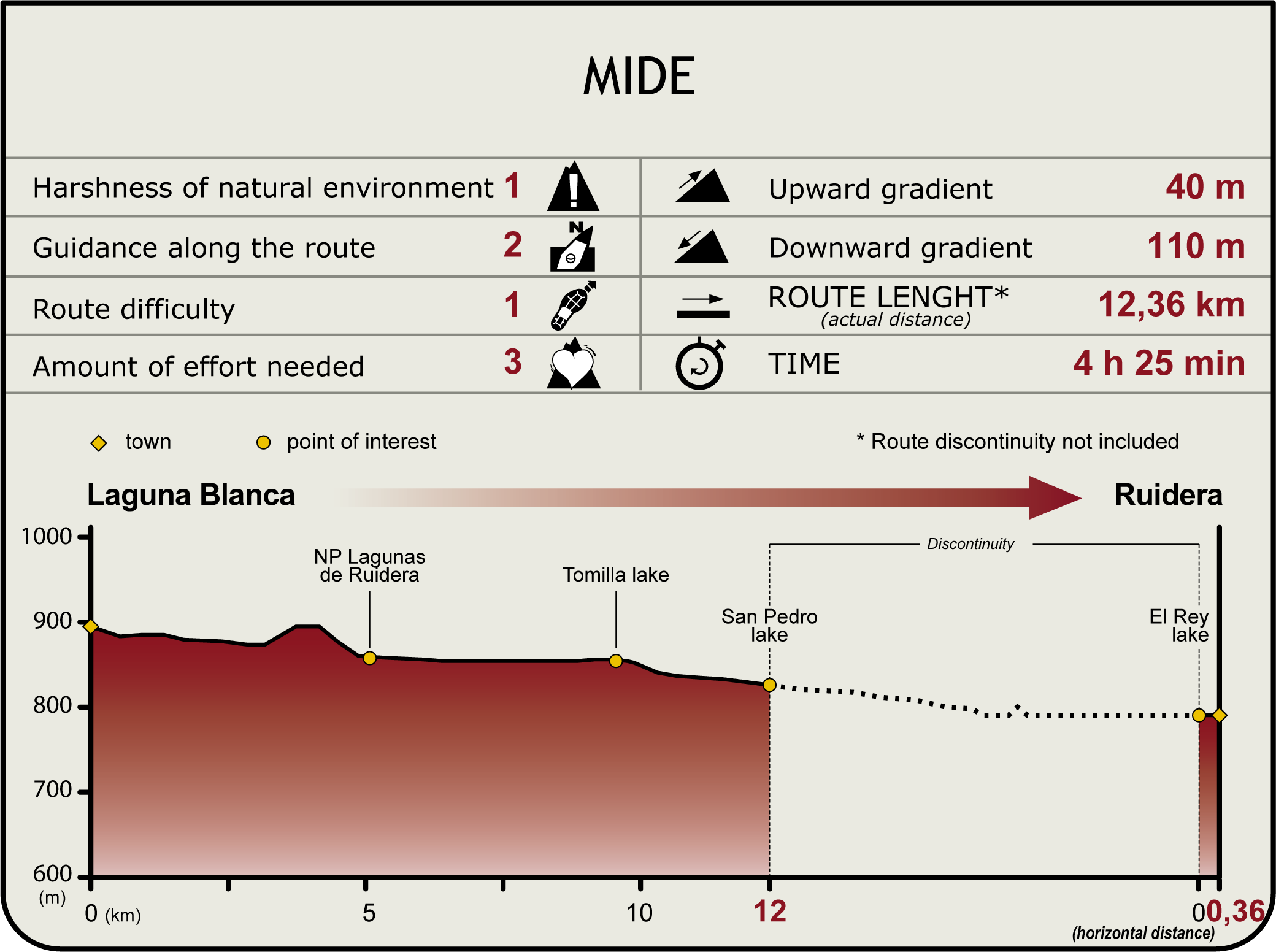
Highlights
Further information
Ruidera Nature Park
Las Lagunas de Ruidera is a wetland of enormous limnological, geomorphological and flora value. It was formed when natural tuff barriers created impoundments along the River Guadiana. These dams are formed by calcium carbonate precipitation that creates a barrier that impounds water. The staggered distribution of the lagoons along the valley is due to the impermeable bed of the lagoons.
The platform on which the park stands consists of thick, horizontally-layered Mesozoic sediments (200 million years ago). The bottom clay layer provides an impermeable coating to the land where the headwaters and springs are located. The dolomitic limestone that forms the upper layer is highly permeable due to its composition and fractures. This can be seen on the nearby cliffs.



